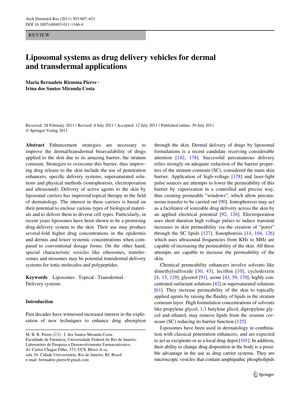Liposomal Systems as Drug Delivery Vehicles for Dermal and Transdermal Applications
July 2011
in “
Archives of Dermatological Research
”
liposomal systems dermal applications transdermal applications bioavailability liposomes hydrophilic substances lipophilic substances local drug concentrations systemic absorption controlled delivery skin barrier recovery therapeutic peptides skin cancer treatments photodynamic therapy ethosomes transfersomes

TLDR Liposomal systems show promise for delivering drugs through the skin but face challenges like high costs and stability issues.
The document from July 30, 2011, reviews the use of liposomal systems as drug delivery vehicles for dermal and transdermal applications, emphasizing their potential to enhance the bioavailability of drugs on the skin. Liposomes can enclose both hydrophilic and lipophilic substances, improve local drug concentrations, decrease systemic absorption, and facilitate controlled delivery through the skin. They have been approved for clinical use and have shown efficacy in treating conditions like acne vulgaris. Liposomes can also form a drug reservoir on the skin, deliver therapeutic peptides, aid in skin barrier recovery, and have been used in skin cancer treatments and photodynamic therapy. Despite their advantages, classic liposomes face limitations in transdermal delivery, leading to the development of specialized vesicular systems like ethosomes and transfersomes with improved properties. However, challenges such as high production costs, stability issues, and complex manufacturing processes have hindered their market availability, indicating a need for further research and development.


